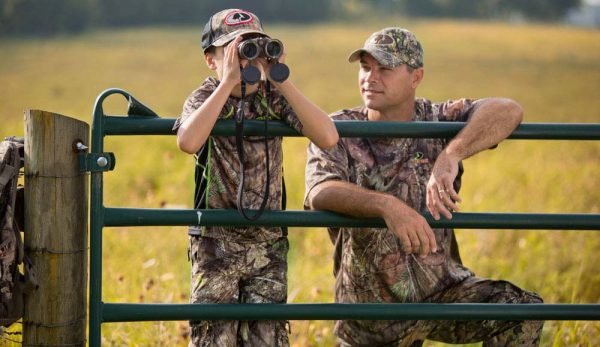When bass spawn, they don’t mess around. In fact, the early spring pre-spawn and full spring spawn are some of the busiest times for bass. They may be active, but catching them is a different story! Even though bass spawning is common in almost all US states, it is a time when bass are frustrating and demanding. This article has information about where and when bass spawn and how to catch spawning bass.
Bass pre-spawn as the water warms, make beds, and then stay there for spring in water just above 60 degrees for spawning.
Warming water temperatures are perfect for finding hard-to-catch big bass because they will be out hunting voraciously for protein before spawning season. The spawning season makes bass slow and sluggish and unwilling to eat anything more than needed. However, as the water temperature warms to just below 60 degrees, the bass spawns, usually in spring.
Table of Contents
Where do Bass Spawn?
If temperatures in water are between 65 – 75°F, largemouth bass will find a shallow protected zone for spawning. Lakes are generally not heated evenly in winter, so not every bass will spawn simultaneously. Typically, the northwest shoreline and lower reservoirs start generating the best warm waters for bass spawning.
The breeding areas must get direct sunlight exposure, so anglers should seek shallow flats away from rough shorelines. It can generally be within 10 feet of the shore and have depths from 1 to 6 feet. These areas are well protected, warmer, and provide direct sunlight for the largemouth bass to spawn.
The male selects a place easily accessible near a sandbox, near a hollow of birch, near the cliffs, or within a short distance from the water’s edge. Take advantage of natural elements that could hide the post-spawn bass in shallow water with topwater lures that get around shallow cover.
Find the Best Places during Bass Spawning Season
Understanding spawning behavior in shallow lakes helps bass anglers catch big fish all season long! Generally speaking, deep water has colder temperatures, so when the spawning bass start feeding and making beds, it is best to cast into waters no deeper than one to six feet of water.
It’s all a matter of determining the most beneficial spring fishing spot in the correct waters. Remember that though pre-spawn Bass are generally relatively shallow, they like being near the deepest waters. They prefer to go to areas where spawning areas may be reached by swimming shorter horizontal distances.
Find these places out of the usual route but with good bass behavior. You’ll want to avoid the heavily fished areas, such as near a dock or other heavily populated locations. The spawning season bass in these locations is a bit more skillful. Instead of giving into fishing pressure and going for well-known spots, use your fishing skills and target bass in areas that make sense for pre-spawn feeding and warm water spawning. These areas include:
- Shallow sandy waters near deep water
- Near shallows; 1-6 feet of water
- Near covers like stumps, branches, or shaded dock pilings
Remember that bass pre-spawn feeding is very heavy in these areas. Finding where the spawn will take place will help anglers with bass fishing because the bass feed near their spawning areas.
Baits for When Bass Spawn
One of the most tricky things during the spawning season is picking a good bait that gives you an excellent chance of getting large bass. It is challenging to beat jigs and other underwater lures. However, you could always tip it up with scent trailers.
Baits for bass spawn are best used with lures. If you get a lure created with a sonic scent that draws bass in, attaching something like a PowerBait keeps the scent attraction strong. Another good option might be live bait, as bass are hungry and feeding heavily in pre-spawn because they know that they will not be feeding in the 10-14 days of the spawn.
Luckily, not all bass spawn at the same time on the lake. Whatever baits you use, make sure you slow down and use more than one cast. Give your bass ample chances to respond to your bait offering.
Best Bass Spawning Baits
Bass feed voraciously leading up to the spawn, so choosing a lure is just as important as the position where you cast it. Spinnerbaits in the grass and other covers make incredible work of tempting hungry pre-spawn bass out. Seeing them and feeling them striking is best discovered with spinnerbaits.
Topwater bait works best on reedbeds’ exterior edges and secondary points, beneath the cover and underneath beds. After cold weather passes, the bass isn’t looking for deep waters to hide. Instead, you’ll need to seek them and turn them up from their shallow-water cover using a jig and a worm.
When you use Spinners or jigs, the point is to surprise and tempt striking bass. You may find bedding bass and get an initial strike. Don’t be confused if you get nothing afterward. You’ve found a bedding bass but have not caught it.
Bedding bass will strike and then back down. It may be time for a swimbait lure. Catching bass in bed is easier with the anatomical appearance of the swimbait. If the bass is aiming at you, look at the pectoral fins. If they are “revolving” or the fish becomes greener or darker, he is biting, which is a worthwhile place to continue angling.
How Do You Know When Bass are Spawning?
It’s easy to say that bass spawning begins with spring, but when exactly is that? Bass breeding season means plenty of hungry largemouth bass on the move. Just as we like getting outdoors and barbequing with a few cold ones in the warmer months, bass seek comfort, food, and a safe place to bed down as the weather warms.
You’ll know it’s the beginning of the spring spawn when you see a few things that bass are doing and where they are located.
Check the shallow areas with warmer water temperatures and underwater structures that could protect the bass. The bass will move towards shallow flats from deeper wintering areas during the pre-spawn stages. After this, the following reproduction steps are called spawn. The bass clears a nest at the hard bottom base before hatching eggs and fertilizing them.
You’ll know when the bass is spawning by feeling the temperature of the water and air get warmer and also if you test out areas of shallow water with jigs or spinners. Aggressive strikes and frenzied movement are good signs that the bass is preparing for spawning.
Do Bass Bite When They Are Spawning?
Getting fish in their spawning beds is often very easy. The more you see the bass, the easier the bite is. There are some methods better than others.
Surprise is the name of the game when. Sneaking up on the bass during spawning is crucial. Have your electric trolling motor installed and ready for when you find that largemouth bass bed.
Bass may be less aggressive and not as apt to bite while bedding. Swimbait or worms are best for bedding bass. These baits give the impression of an easy meal that even a spawning bass won’t pass up.
How long does the bass spawn last?
Generally, the bass doesn’t waste time. Once the water temperature triggers the spawn, they are off and swimming. The spawning cycle can last from three weeks on larger lakes to mere days on smaller ones.
What Month is Spawn For Bass?
If the water temperature remains above 60 degrees F (15.6 degrees Celsius), the male bass moves into the feeding ground. Mostly the spawn is found in the Spring months — April, May, or even early June — but bass are a widely distributed species which means location plays an important part.
How Many Times Does a Bass Spawn In a Year?
Usually, it’s done at least three times during a single season, but two seem to represent more familiar numbers. Temperatures directly influence eggs, and, in enough hot water, bass fry may hatch in only two days! Hundreds, if not thousands, of fertilized eggs could be laid in such conditions.
What is the Best Temperature for Bass Fishing?
Although bass bites readily at water temperatures between 684 and 884 F, a water temperature of around 77-88 degrees F is ideal for bass catching consistently. Bass in a deeper hole at the main lake.
What Water Temperature Are Bass Most Active?
It is generally about 55-70 Celsius during spawning periods. After the fish spawns and the bass leaves the bed, spawning starts post-spawn. It runs from summer onward, which is a perfect time for fishing. The temperature ranges between 75 and 70 degrees Celsius.
What Are The Best Months for Bass Fishing?
Fishing for bass is always a challenge and an exciting opportunity. During winter, fishing can come alive even in cold temperatures at more profound water depths. However, the warm afternoons, especially during spring, are generally the best months for bass fishing.
Fish the Best Bass During Spawning with NewJen Bass
If you think you have what it takes to find lunkers as they feed in pre-spawn or bed down, NewJen Bass offers the highest quality locations for challenging Northern California anglers. As one of the most celebrated and honestly run bass fishing organizations in the Western United States, NewJen Bass offers hundreds of thousands of dollars in tournament money and prizes and is even offering brand new boats for the 1st place winners in each of their tournament divisions for the 2022 bass fishing season.
Become part of the family and get treated like family when you fish Northern California’s best bass fishing destinations with NewJen Bass. It’s more than a tournament…it’s an experience!
Sources:





